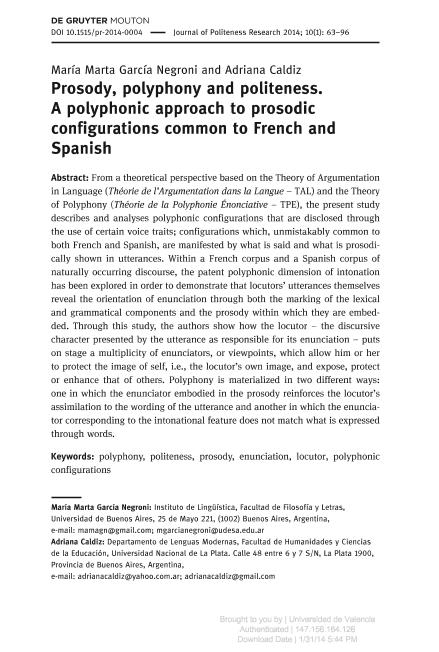Artículo
Prosody, polyphony and politeness: A polyphonic approach to prosodic configurations common to French and Spanish
Fecha de publicación:
01/2014
Editorial:
De Gruyter
Revista:
Journal of Politeness Research
ISSN:
1612-5681
e-ISSN:
1613-4877
Idioma:
Inglés
Tipo de recurso:
Artículo publicado
Clasificación temática:
Resumen
From a theoretical perspective based on the Theory of Argumentation in Language (Théorie de l’Argumentation dans la Langue – TAL) and the Theory of Polyphony (Théorie de la Polyphonie Énonciative – TPE), the present study describes and analyses polyphonic configurations that are disclosed through the use of certain voice traits; configurations which, unmistakably common to both French and Spanish, are manifested by what is said and what is prosodically shown in utterances. Within a French corpus and a Spanish corpus of naturally occurring discourse, the patent polyphonic dimension of intonation has been explored in order to demonstrate that locutors’ utterances themselves reveal the orientation of enunciation through both the marking of the lexical and grammatical components and the prosody within which they are embedded. Through this study, the authors show how the locutor – the discursive character presented by the utterance as responsible for its enunciation – puts on stage a multiplicity of enunciators, or viewpoints, which allow him or her to protect the image of self, i.e., the locutor’s own image, and expose, protect or enhance that of others. Polyphony is materialized in two different ways: one in which the enunciator embodied in the prosody reinforces the locutor’s assimilation to the wording of the utterance and another in which the enunciator corresponding to the intonational feature does not match what is expressed through words.
Palabras clave:
Prosodia
,
Polifonía
,
Cortesía
,
Francés-Español
,
Enunciación
,
Locutor
Archivos asociados
Licencia
Identificadores
Colecciones
Articulos(SEDE CENTRAL)
Articulos de SEDE CENTRAL
Articulos de SEDE CENTRAL
Citación
Garcia Negroni, Maria Marta; Caldiz, Adriana Mabel; Prosody, polyphony and politeness: A polyphonic approach to prosodic configurations common to French and Spanish; De Gruyter; Journal of Politeness Research; 10; 1; 1-2014; 63-96
Compartir
Altmétricas




